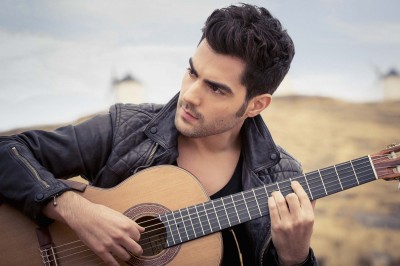
Cleveland Orchestra gets Miami residency underway
The Cleveland Orchestra makes it first reappearance of the season this week with two evening concerts at the Knight Concert Hall, escaping the polar vortex as it settles in on northeast Ohio.
But the orchestra actually will begin shaking off the cold tomorrow morning with a children’s program for fourth-graders in the Miami-Dade County school system. The official Miami residency conductor, Giancarlo Guerrero, will lead the group in pieces that demonstrate the different sections of a symphonic ensemble: Benjamin Britten’s Young People’s Guide to the Orchestra; the finale of Antonín Dvořák’s Serenade for Winds; the finale of Tchaikovsky’s Serenade for Strings; and the Fanfare for the Common Man of Aaron Copland, which is a thrilling demonstration piece for brass and percussion.
Also on hand for the media after the educational program will be the young Montengrin guitarist Miloš Karadaglić, who in Friday and Saturday night’s concerts will play the Concierto de Aranjuez of the blind Spaniard Joaquín Rodrigo, by a long way the most popular of all guitar concertos, particularly for its moody slow movement; Karadaglić released a recording of the work earlier this year with the London Philharmonic and Yannick Nézet-Séguin at the helm.
“I get the goosebumps in my hair, and I know it’s right,” Karadaglić told me last year about playing that slow movement. “That’s the nicest feeling in the world.”
In addition to the Rodrigo concerto, the Cleveland’s concerts will feature two pieces of “tourist” music by Russian composers, the Capriccio Espagnol of Rimsky-Korsakov and the Capriccio Italien of Tchaikovsky, plus a piece by one of Rimsky’s students, Fountains of Rome, by the Italian composer Ottorino Respighi.
Educational outreach is among the most critical exercises of today’s classical music institutions, not to mention providers of visual art, dance and theater. Earlier this year, I talked to Holly Hudak, the managing director of the Cleveland Orchestra’s Miami residency and the former manager of the Chicago Youth Symphony, about the season to come and educational outreach in particular.
“(The orchestra) is famous in Cleveland for the work that it’s doing with young people [in the city] and developing audiences for the future,” Hudak said, including its under-18 ticket offerings, which have been replicated at the Knight hall. “We now have a program in Miami where if a ticket buyer purchases one ticket, we will give them a companion ticket for an under-18 student, free of charge.”
That’s not the only thing the orchestra wants to do.
“The difference today is there are so many more things competing for the attention of the young people coming up. But I think we can respond to that with trying to find more innovative ways, and places, and opportunities, of reaching young people,” she said.
In the not-too-distant past, the only way to interact with classical music was to get out the fancy clothes and head to the concert hall, Hudak said. But these days, particularly with the digital revolution that has brought an astonishing wealth of new and historic performances to outlets such as YouTube, that audience is bigger and much more diverse, but also more fragmented.
“We just need to keep focusing on: how can we break down the barriers? How can we take classical music to where people we want to reach are?” Hudak said, mentioning the Cleveland’s pop-up concerts in various city neighborhoods as one way of doing that. “And that goes as much for the technology and interactive ways of reaching people as it does the in-person ways.”
This week’s concerts are set for 8 p.m. Friday and Saturday at the Knight Concert Hall in the Adrienne Arsht Center for the Performing Arts. Call 305-949-6722 for tickets or visit www.clevelandorchestramiami.com.
Recent Content
-
Artsarticle ·
-
Artsarticle ·
-
Artsarticle ·

